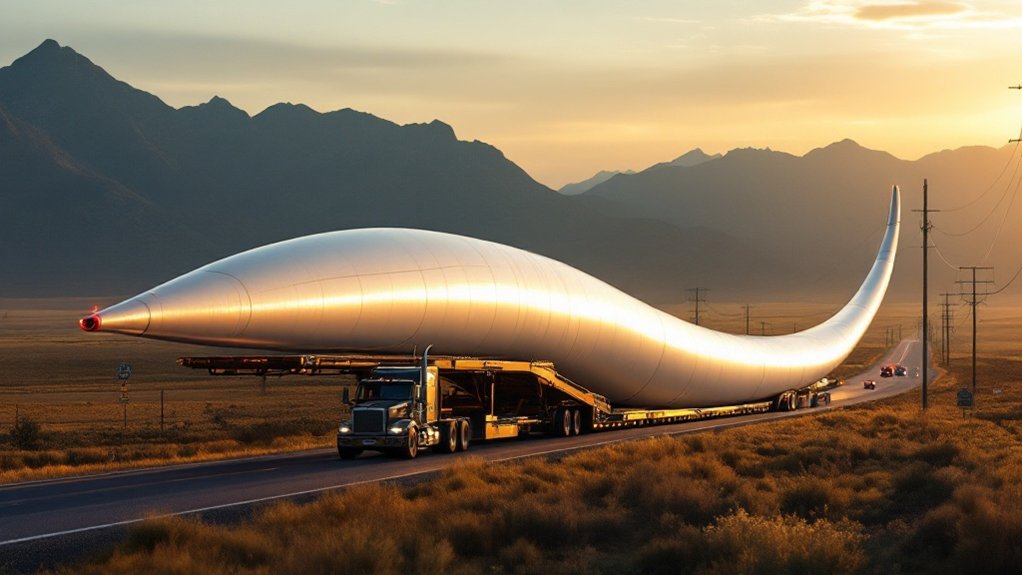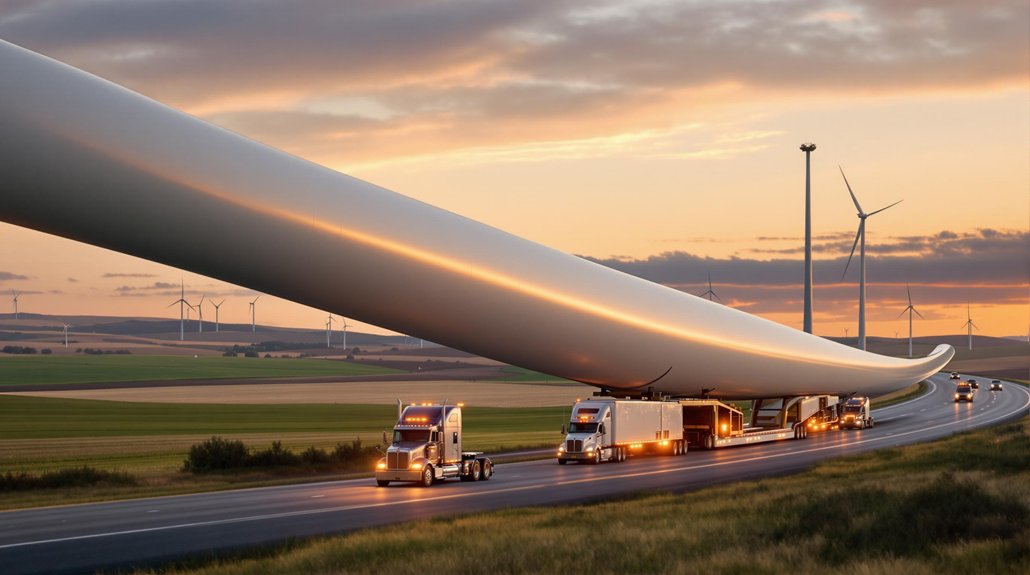Transporting wind turbine blades presents enormous logistical challenges. These massive components can reach 100 meters long and weigh up to 36 tons each. Companies use specialized equipment like extendable trailers and hydraulic lifts to navigate obstacles. Each transport requires extensive route planning, multiple permits costing thousands of dollars, and police escorts. Rural locations with poor infrastructure create additional difficulties. The industry is exploring segmented designs and on-site manufacturing to overcome these transportation hurdles.

Dozens of massive wind turbine blades travel across America’s highways every day, creating unique transportation challenges. These blades, stretching up to 100 meters long and weighing between 12 and 36 tons each, require specialized equipment and careful planning to move safely from factories to wind farm sites.
Companies use various methods to transport these enormous components. Heavy haul trailers designed specifically for blade transport are most common on highways. Rail transport with specialized cars helps move blades over long distances. For offshore wind farms, barges carry the blades to their final destinations. Sometimes a combination of these methods works best.
Moving blades requires a specialized toolkit: custom trailers on highways, rail cars for distance, and barges for offshore destinations.
The logistics of blade transport begin with detailed route surveys. Teams identify potential obstacles like narrow roads, tight turns, bridges, and power lines. Each state requires different permits for oversized loads, with costs ranging from $1,000 to $5,000 per state. Police escorts, often mandatory, add another $1,000 or more per day.
Special equipment makes blade transport possible. Extendable trailers, sometimes 200 feet long, carry the blades horizontally. Hydraulic lifts can tilt blades vertically to maneuver around obstacles. Self-steering rear axles help drivers manage tight turns. Each trailer costs more than $100,000, contributing to transport costs that can exceed $100,000 per turbine.
Rural wind farm locations create additional challenges. Many remote areas have poor roads not designed for heavy loads. Weather and seasonal conditions affect planning, as do traffic patterns in populated areas. Transport companies must secure permits from multiple jurisdictions along the route. Many transportation companies implement nighttime transportation to reduce traffic disruption and enhance safety during the movement of these massive components. Despite these challenges, the industry continues to expand as wind power becomes an increasingly renewable energy source that helps reduce carbon emissions worldwide.
New solutions are emerging to address these challenges. Some manufacturers are developing segmented blade designs that can be assembled on-site. Others are exploring on-site manufacturing to eliminate transport altogether. There’s even research into using airships for deliveries to remote locations.
Despite these innovations, the sight of massive turbine blades traversing America’s highways remains common as the wind energy industry continues to grow, facing and solving logistical challenges along the way.
Frequently Asked Questions
How Much Does a Typical Wind Turbine Blade Weigh?
Wind turbine blade weights vary based on size. A 1.5 MW turbine blade weighs about 5,200 pounds, while a 2 MW blade weighs around 11,500 pounds.
Larger 3 MW blades can reach 27,000 pounds. Offshore turbine blades often exceed 66,000 pounds.
The weight increases as blades get longer. Manufacturers are using carbon fiber and new technology to make blades lighter while maintaining strength.
What’s the Average Cost to Transport a Wind Turbine Blade?
The average cost to transport a wind turbine blade varies greatly based on distance.
Short-haul transport (under 500 miles) typically costs $30,000-$40,000 per blade. Long-distance shipping can exceed $100,000.
These prices include trucks, trailers, drivers, permits, and escort vehicles.
Factors affecting cost include blade length, route complexity, and seasonal considerations.
Some companies use rail or multi-modal options to reduce expenses when possible.
Do Transportation Companies Need Special Permits for Blade Transport?
Companies transporting wind turbine blades must obtain special permits.
These oversized load permits are required by each state along the transport route. The permits specify approved paths, travel time restrictions, and escort vehicle requirements. Costs vary widely between states, ranging from $15 to over $1,000.
The application process involves submitting detailed route plans, load specifications, and proof of insurance. This permitting process can take weeks or months to complete.
How Long Does Blade Transportation Typically Take From Factory to Site?
Wind turbine blade transportation typically takes 3-8 weeks from factory to installation site.
The journey includes 1-3 days from factory to port, 1-2 days for port operations per blade, 2-6 weeks for ocean shipping, and 3-7 days for trucking to the final location.
Factors like blade length, route complexity, weather conditions, and permit processing times can extend this timeline considerably.
What Happens to Damaged Blades During Transportation?
When wind turbine blades get damaged during transportation, they undergo immediate assessment.
Minor damage is repaired on-site with composite patches. Moderate damage may require removal for repairs at specialized facilities. Severely damaged blades typically need full replacement, costing up to $150,000.
All damage is documented with photos and classified based on severity.
Repair costs range from $3,000-$30,000 per blade, while transportation delays add $1,000-$2,000 daily.









